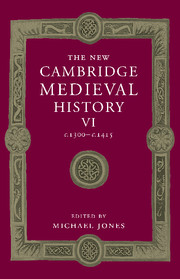Book contents
- Frontmatter
- Part I General Themes
- 1 Introduction
- 2 The Theory and Practice of Government in Western Europe in the Fourteenth Century
- 3 Currents of Religious Thought and Expression
- 4 The Universities
- 5 Rural Society
- 6 Urban Life
- 7 Plague and Family Life
- 8 Trade in Fourteenth-Century Europe
- 9 Chivalry and the Aristocracy
- 10 Court Patronage and International Gothic
- 11 Architecture
- 12 Literature in Italian, French and English: Uses and Muses of the Vernacular
- Part II The States of the West
- Part III The Church and Politics
- Part IV Northern and Eastern Europe
- Appendix Genealogical Tables
- Primary Sources and Secondary Works Arranged by Chapter
- Index
- Frontispiece
- Plate section
- Map 4 Europe's trade, c. 1300
- Map 5 Europe's trade, c. 1400
- Map 7 The Hundred Years War to 1360
- Map 15 Russia, c. 1396
- Map 17 The Byzantine empire in the 1340s
- References
7 - Plague and Family Life
from Part I - General Themes
Published online by Cambridge University Press: 28 March 2008
- Frontmatter
- Part I General Themes
- 1 Introduction
- 2 The Theory and Practice of Government in Western Europe in the Fourteenth Century
- 3 Currents of Religious Thought and Expression
- 4 The Universities
- 5 Rural Society
- 6 Urban Life
- 7 Plague and Family Life
- 8 Trade in Fourteenth-Century Europe
- 9 Chivalry and the Aristocracy
- 10 Court Patronage and International Gothic
- 11 Architecture
- 12 Literature in Italian, French and English: Uses and Muses of the Vernacular
- Part II The States of the West
- Part III The Church and Politics
- Part IV Northern and Eastern Europe
- Appendix Genealogical Tables
- Primary Sources and Secondary Works Arranged by Chapter
- Index
- Frontispiece
- Plate section
- Map 4 Europe's trade, c. 1300
- Map 5 Europe's trade, c. 1400
- Map 7 The Hundred Years War to 1360
- Map 15 Russia, c. 1396
- Map 17 The Byzantine empire in the 1340s
- References
Summary
around 1300, it seemed that the population, to some degree everywhere in Europe, had attained its maximum and reached a ceiling. There were still few signs allowing one to foretell the slowing-down of the expansion begun almost three centuries before; these signs were to multiply in the first half of the fourteenth century. It was then, in the very middle of the century, that the terrible knell of the Black Death sounded. Thus a period opened characterised by the deadly and repeated attacks of what contemporaries interpreted as a sign of divine anger provoked by human depravity. The century closed, in fact, with another major epidemic of the terrible illness and the fifteenth, begun in an atmosphere of mourning, was to bear its ineradicable stigmata. The plague henceforth accompanied medieval man as ineluctably as, to use the words of Alain Chartier, ‘the abominable sum of infinitely wicked evils’: hunger, war, death.
No historian doubts that the brutal irruption of a scourge which was to become a pandemic and affect the European population for centuries stimulated profound upheavals in modes of production, living and feeling. An evaluation of the precise effects of the epidemic, of its place in the period’s procession of evils, is more difficult. Did the plague, falling upon Europe, operate autonomously to subvert or renew the structures of feudal society? Was the terrifying skeleton which led an entire society in the Dance of Death the model on which historians should base their analyses?
- Type
- Chapter
- Information
- The New Cambridge Medieval History , pp. 124 - 154Publisher: Cambridge University PressPrint publication year: 2000
References
- 3
- Cited by

